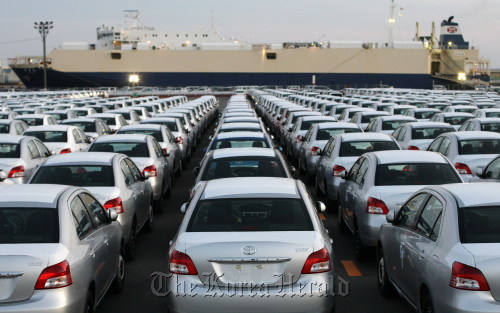Japan’s exports increased more than expected in September as demand for cars and auto parts rose, a sign the recovery in shipments is withstanding a weakening global economy.
Shipments rose 2.4 percent last month from a year earlier, the Ministry of Finance said in Tokyo Monday. The median estimate of 26 economists surveyed by Bloomberg was for a 1 percent increase after a 2.8 percent gain in August. The nation posted a trade surplus of 300 billion yen ($3.9 billion).
Exports have rebounded as companies including Toyota Motor Corp. restored production after the March 11 earthquake and tsunami damaged factories and caused parts and power shortages. Threatening to stunt shipments are a yen strengthening to a post-World War II high and a slowdown abroad including in China, Japan’s largest overseas market.
“The report provides some relief as it indicates that exports aren’t plunging,” said Yoshiki Shinke, a senior economist at Dai-Ichi Life Research Institute in Tokyo. Still, “we can’t be bullish about the outlook of exports given slowdowns in the U.S., Europe and emerging nations such as China.”
The yen traded at 76.35 against the dollar at 10:11 a.m. in Tokyo, little changed from the level before the report. It advanced to a postwar high of 75.82 on Oct. 21, and has strengthened more than 6 percent against its U.S. counterpart this year. The Nikkei 225 Stock Average rose 1.4 percent as commodity producers gained on higher oil and metal prices.
 |
Toyota Motor Corp. Yaris compact vehicles bound for export sit in a lot at the port of Sendai, Japan. (Bloomberg) |
Japanese Finance Minister Jun Azumi said Monday that the yen’s climb to a new postwar high was “extremely unfortunate.” Azumi signaled that Japan is ready to intervene to stem the gains, telling reporters in Tokyo he will take “decisive” action in the market, and saying that the yen’s moves are “clearly speculative and don’t reflect economic fundamentals at all.”
Exports rose 2 percent from August. Helping push up overall shipments were a 4.9 percent increase in car exports and an 11.5 percent gain in auto part sales, according to Monday’s data. Exports to China rose 2.7 percent, the report showed.
Imports advanced 12.1 percent from a year earlier as purchases of petroleum and liquefied natural gas gained, according to the report.
Toyota, Asia’s biggest carmaker, reported an increase in global vehicle output for the first time in 12 months in August. At the same time, the automaker loses 34 billion yen in operating profit for every 1 yen appreciation against the dollar.
Prime Minister Yoshihiko Noda’s cabinet last week approved a 12.1 trillion yen spending plan to rebuild after the March disaster. The package includes 2 trillion yen to help companies cope with the higher yen, with subsidies planned for building plants in Japan and hiring workers.
Recent Japanese economic data have suggested that the currency appreciation and a global slowdown are taking their toll on the world’s third-largest economy. Industrial output, retail sales and exports were all weaker than economist forecasts in August.
Goldman Sachs Group Inc. this month cut its forecast for Japan’s economic growth to 2.1 percent in the fiscal year starting April 2012 from of an earlier estimate of 2.5 percent, in line with its prediction of a slower global expansion.
The International Monetary Fund last month lowered its forecast for global economic growth this year to 4 percent from 4.3 percent. China’s expansion moderated to 9.1 percent in the third quarter from a year earlier, the slowest pace since 2009.
(Bloomberg)




![[Herald Interview] 'Trump will use tariffs as first line of defense for American manufacturing'](http://res.heraldm.com/phpwas/restmb_idxmake.php?idx=644&simg=/content/image/2024/11/26/20241126050017_0.jpg)

![[Health and care] Getting cancer young: Why cancer isn’t just an older person’s battle](http://res.heraldm.com/phpwas/restmb_idxmake.php?idx=644&simg=/content/image/2024/11/26/20241126050043_0.jpg)

